
Overview
The article titled "10 Key Insights on Conversion Rate Averages for DTC Brands" serves as a crucial guide for direct-to-consumer (DTC) brands aiming to elevate their conversion rates. It asserts that the average conversion rate for DTC companies generally falls between 3% and 5%. This benchmark underscores the necessity of implementing personalized marketing strategies, enhancing user experiences, and leveraging data-driven optimization techniques. By mastering these approaches, DTC brands can not only meet but exceed these benchmarks, ultimately driving improved profitability.
Introduction
In the fiercely competitive landscape of direct-to-consumer (DTC) brands, understanding conversion rate averages is crucial for sustainable growth. With the average conversion rate hovering around 2.9% across various industries, DTC companies, particularly in fashion and beauty, often exceed this benchmark, achieving rates between 3% and 5%.
However, as businesses strive to enhance their performance, the challenge remains: what strategies can effectively elevate conversion rates and ensure that brands not only meet but surpass industry standards?
This article delves into expert insights and proven methodologies for optimizing conversion rates, offering valuable guidance for DTC brands aiming to thrive in an ever-evolving market.
Parah Group: Expert Strategies for Maximizing Conversion Rates
Parah Group adopts a systematic approach to Conversion Rate Optimization (CRO), leveraging data-driven techniques and consumer psychology to enhance the conversion rate average for direct-to-consumer (DTC) labels. This method is underscored by key methodologies such as:
- User session recordings, which offer invaluable insights into visitor behavior
- Competitor analysis that reveals market opportunities
Furthermore, continuous A/B testing—utilized by approximately 75% of leading online retailers—refines these strategies, empowering companies to implement informed modifications based on real-time data.
The results of this systematic approach are remarkable, exemplified by a 36% increase in ROI on advertisements for clients. Businesses that employ CRO tools typically experience an average return on investment that reflects a conversion rate average of 223%. By focusing on the enhancement of existing resources, Parah Group enables DTC companies to unlock their full growth potential in a competitive landscape.
As Sneh Choudhary articulates, CRO is fundamentally rooted in analytics and user feedback, fostering a culture that champions informed, data-driven decision-making.
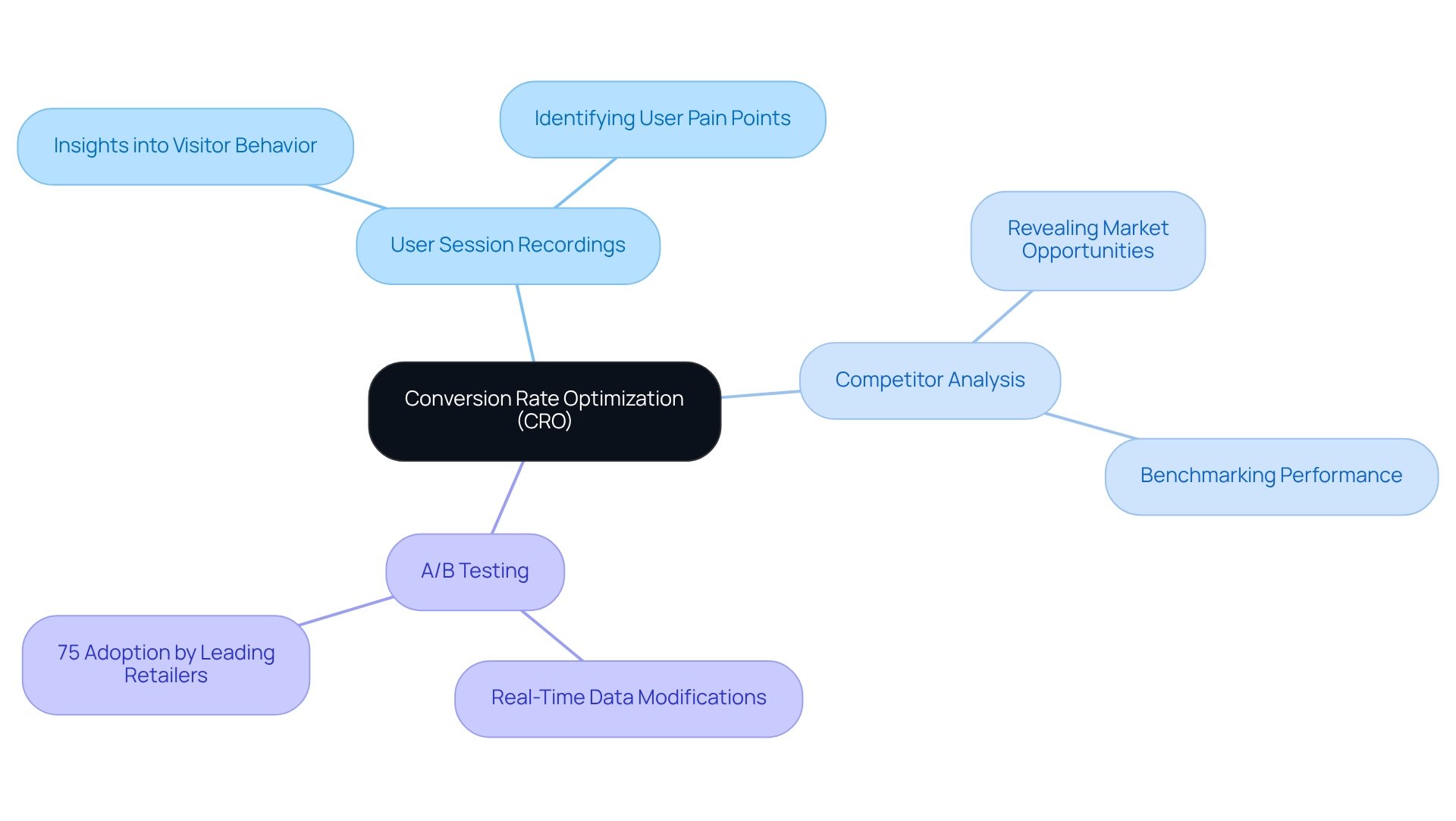
Average Conversion Rates by Industry: Key Benchmarks for DTC Brands
As of 2025, the average changeover percentage across various sectors stands at approximately 2.9%. However, direct-to-consumer (DTC) companies, especially within the fashion and beauty industries, frequently achieve higher success rates, typically ranging from 3% to 5%.
For instance, the clothing sector boasts an average transformation percentage of around 4.07%, while food and drink companies can reach impressive figures of up to 6.17%. These benchmarks are critical for DTC companies to assess their performance and refine their strategies.
Notably, companies that effectively implement personalized marketing and enhance user experience often witness significant improvements in their metrics. Success stories from leading DTC companies illustrate that those prioritizing customer engagement and streamlining their purchasing processes can achieve results that exceed industry standards, underscoring the importance of continuous improvement in a competitive landscape.
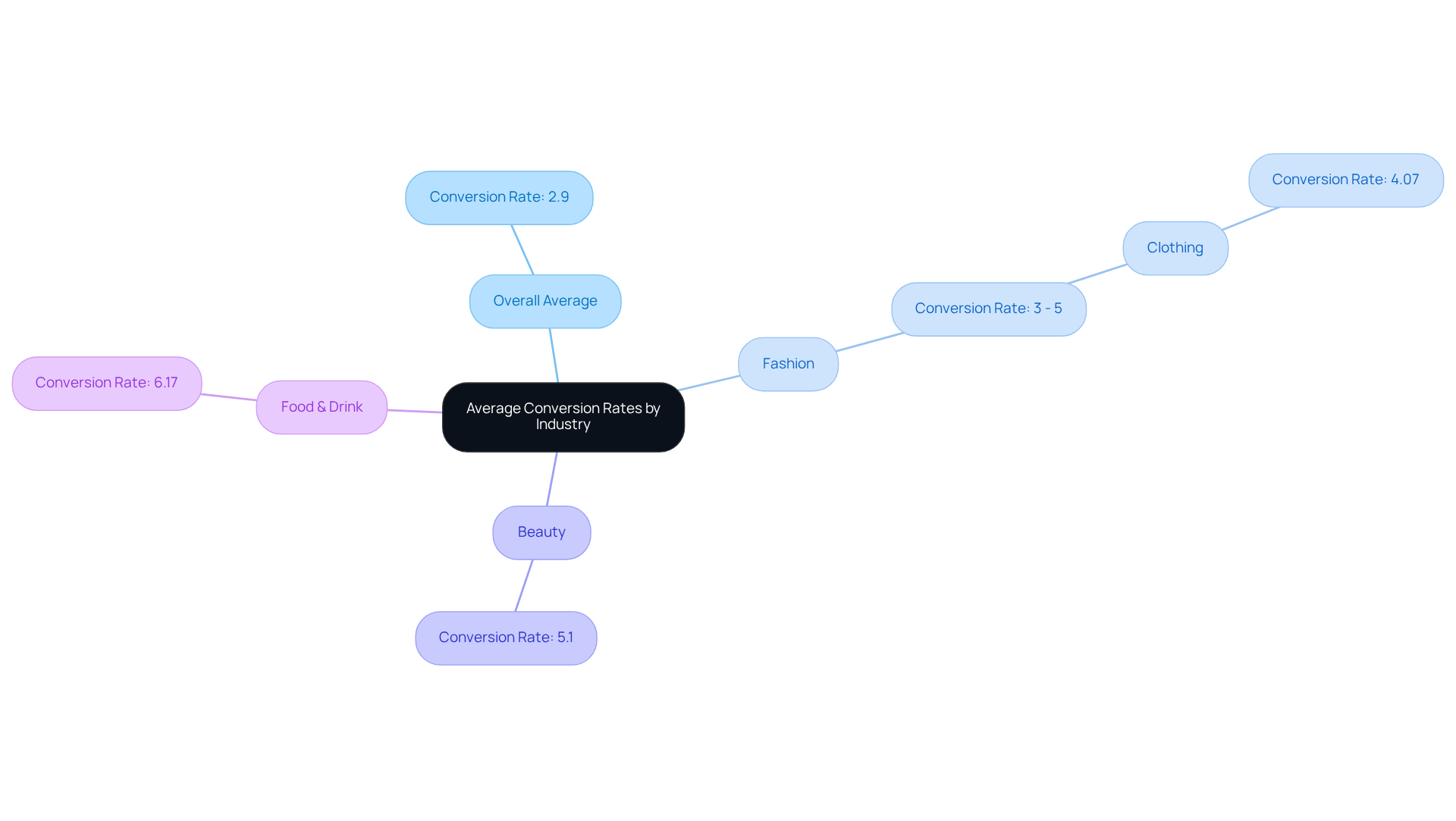
What is Considered a Good Conversion Rate? Insights and Benchmarks
The conversion rate average can vary significantly across sectors; however, in e-commerce, an acceptable range typically lies between 2% and 5%. For direct-to-consumer (DTC) companies, a conversion rate average that exceeds 3% is often regarded as a strong performance metric. Brands operating in competitive industries should strive for even higher levels to set themselves apart.
Continuous monitoring and enhancement of strategy effectiveness are crucial, as many companies report that their conversion rate average increases by 10% to 35% after implementing successful optimization techniques. Established DTC brands, for instance, have effectively leveraged customized landing pages and personalized user experiences to boost their success metrics, demonstrating the impact of strategic adjustments.
Insights from marketing experts underscore the necessity of adapting to market demands and consumer behaviors to maintain and elevate these levels over time.
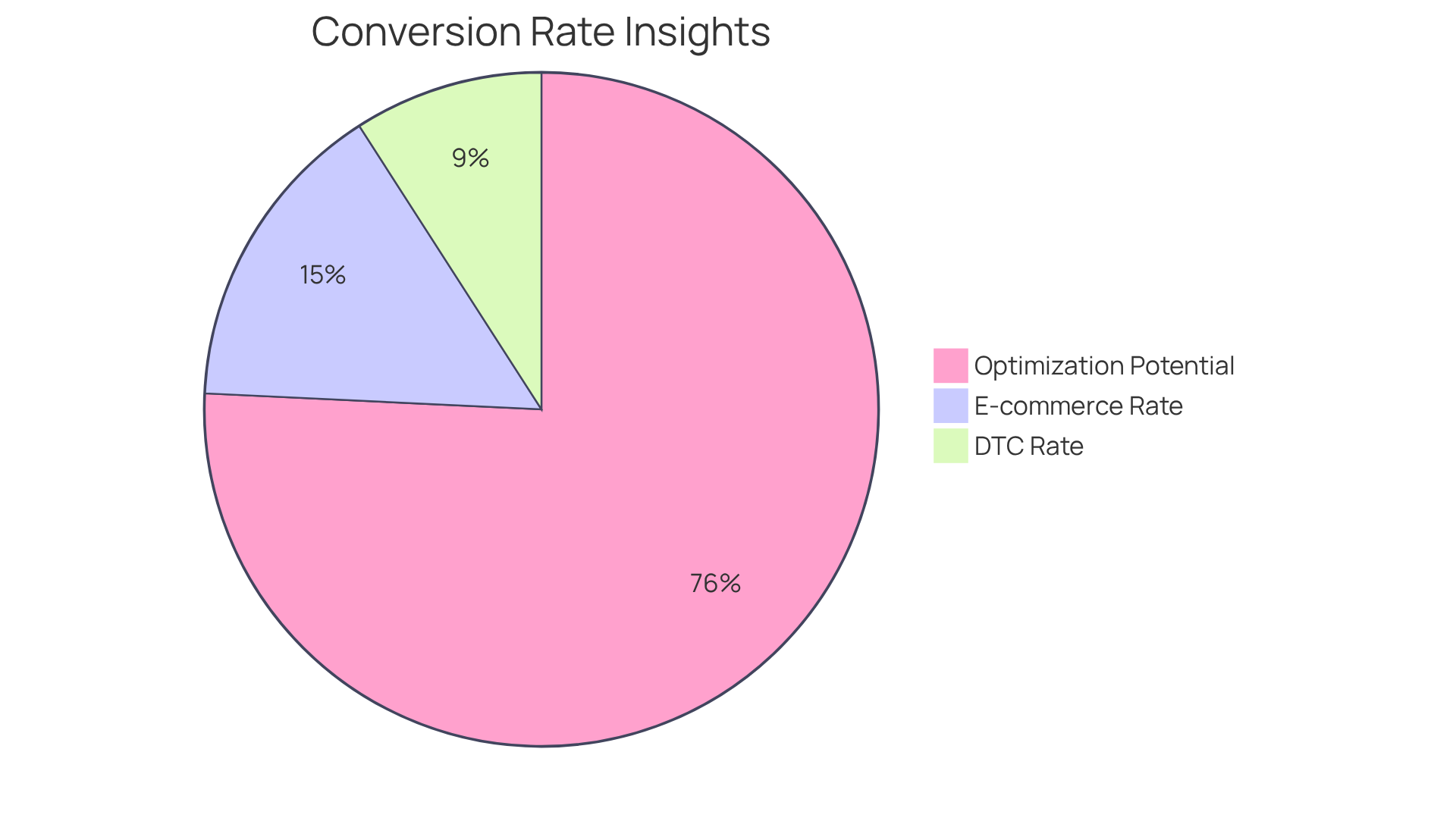
Key Components Influencing Lead Conversion Rates: A Comprehensive Overview
Critical factors, including website layout, user interaction, and the effectiveness of calls-to-action (CTAs), significantly influence the conversion rate average. A well-optimized landing page that loads quickly and is mobile-friendly can substantially improve the conversion rate average and user engagement. Indeed, 88% of users are less likely to return to a site after a negative experience, underscoring the importance of delivering a positive user experience to improve the conversion rate average.
By tailoring customized content and targeted communication to consumer behavior, businesses can further elevate their conversion rate average. For instance, companies that implement superior design practices experience growth that is twice as fast as the industry benchmark, underscoring the importance of aesthetics and functionality in web design.
Moreover, social proof—such as customer reviews and testimonials—plays a vital role in building trust and can significantly influence the conversion rate average. Research indicates that leveraging social proof can boost the conversion rate average and increase the likelihood of success by as much as 161%. Additionally, effective CTAs are crucial; visually appealing CTAs can boost click-through rates by 42%, while those designed with a sense of urgency can lead to a conversion rate average that is 332% higher.
In conclusion, prioritizing user experience, enhancing website design, and crafting engaging CTAs are essential strategies for increasing lead success and improving the conversion rate average to foster business growth.

How to Calculate Lead Conversion Rates: A Step-by-Step Guide
Understanding your conversion rate average is essential for grasping your marketing efficiency and enhancing profitability. To determine your conversion rate, follow these steps:
- Identify the total number of leads generated during a specific period.
- Count the number of leads that successfully converted into customers.
- Apply the formula: (Number of Conversions / Total Leads) x 100.
For instance, if you generated 100 leads and 10 converted into customers, your conversion rate would be 10%. Regularly calculating this metric not only helps businesses identify trends but also highlights areas for improvement that can enhance the conversion rate average. In fact, companies that consistently monitor their performance metrics can achieve up to a 47% increase in order value, showcasing the significant impact of effective lead management strategies. By understanding and refining these figures, DTC brands can enhance their overall profitability and growth.
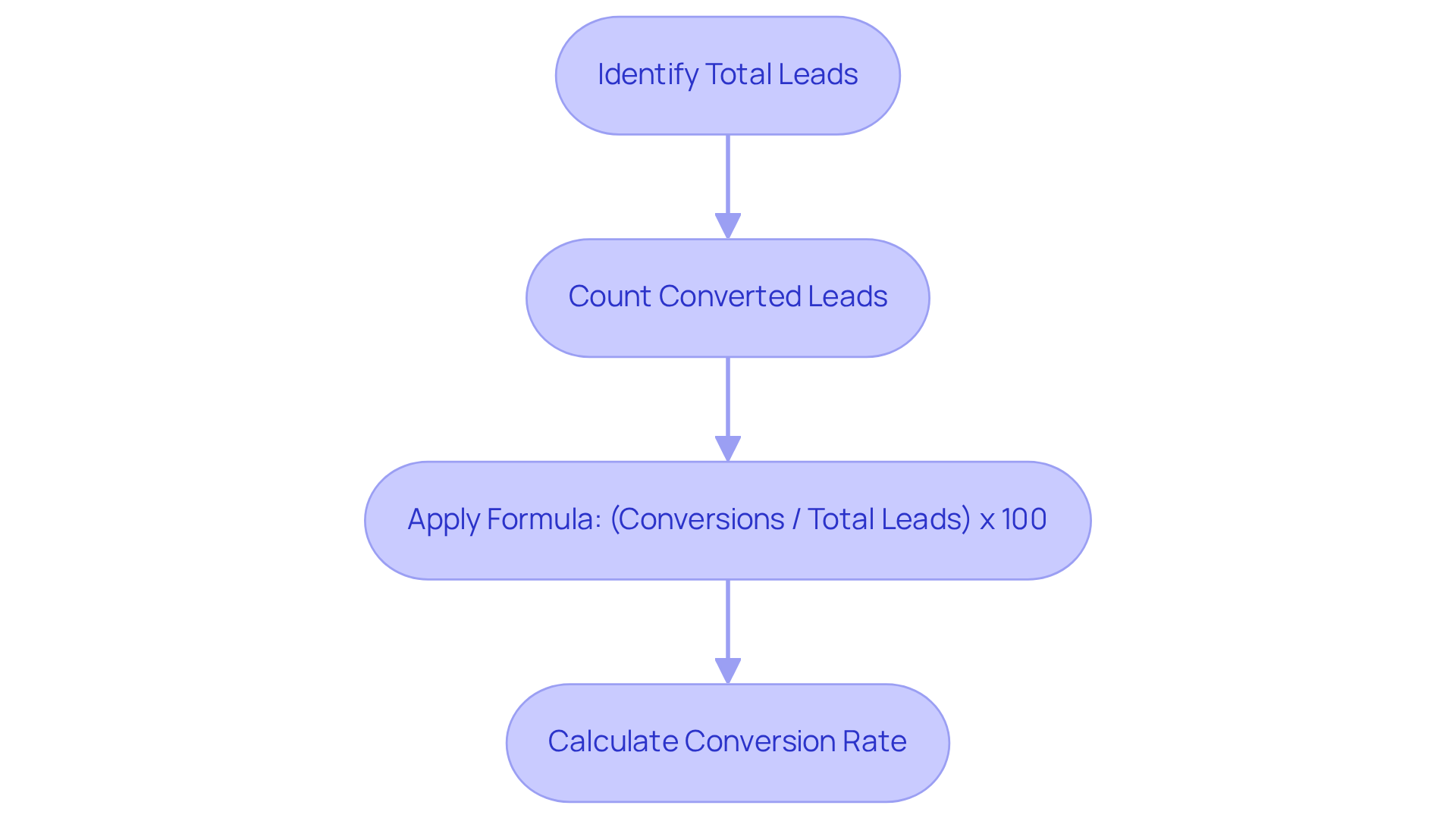
Top Strategies for Improving Your Lead Conversion Rate
To enhance your lead conversion rate, consider implementing the following strategies:
-
Optimize Landing Pages: Ensure your landing pages are clear and load quickly. A one-second enhancement in load time can result in an increase in sales by as much as five times. Parah Group emphasizes that aligning your landing pages with your paid ads is crucial for driving significant growth.
-
Utilize A/B Testing: Conduct A/B testing to identify the most effective calls to action (CTAs) and messaging. Customized CTAs can achieve a 202% enhancement in success metrics, showcasing the effectiveness of personalized strategies. Parah Group's rigorous testing methods ensure that you maximize your existing resources for optimal results.
-
Personalize User Experiences: Leverage data to create personalized experiences based on user behavior and preferences. AI-powered suggestions can enhance sales effectiveness by as much as 15%. This aligns with Parah Group's holistic approach to CRO, which focuses on understanding consumer psychology to enhance profitability.
-
Leverage Social Proof: Incorporate user-generated content and testimonials to build trust. Products with five or more reviews are 270% more likely to be purchased, highlighting the impact of social validation. Parah Group's approaches highlight the significance of social proof in boosting sales.
-
Prompt Follow-Up: Respond to leads swiftly, ideally within five minutes. This can make you 100 times more likely to convert a lead into a customer, emphasizing the importance of timely engagement. Parah Group's experience shows that swift follow-up is a key component of effective CRO.
-
Simplify the Conversion Process: Reduce the number of steps required to complete a purchase. Each extra field in a form can lower success percentages by 5-10%, so simplify your forms to improve user experience. Parah Group promotes a smooth transition procedure as part of their extensive CRO plans.
By applying these strategies, you can not only enhance your lead transformation percentages but also achieve a higher conversion rate average, leading to long-term profitability through efficient optimization.

Essential Tools and Techniques for Accurate Conversion Rate Measurement
To effectively assess the impact of changes, brands must leverage powerful tools such as Google Analytics. This platform provides comprehensive insights into user behavior and tracks transformations with precision. Additionally, heat mapping software like Hotjar offers a visual representation of user interactions on your site, allowing for deeper analysis. A/B testing platforms such as Optimizely further empower brands by identifying the most effective variations of web pages. By implementing these tools, organizations can engage in data-driven decision-making, fostering continuous optimization and enhancing overall performance.

Channel-Specific Conversion Rates: Insights for Targeted Marketing
The conversion rate average reveals notable disparities across various marketing channels. Email marketing emerges as a frontrunner, boasting an impressive average success rate of approximately 10.3%, far exceeding the typical 2-3% seen on social media platforms. This stark contrast underscores the necessity for DTC brands to strategically allocate resources towards email marketing, as it not only drives higher sales but also fosters deeper customer engagement.
Effective email campaigns can achieve a conversion rate average that is up to 36 times greater than traditional marketing methods, showcasing the channel's potential for maximizing profitability. Brands that have refined their email strategies—such as integrating personalized content and automated workflows—report significant improvements in success metrics and overall sales.
For instance, Proffsmagasinet doubled its success metric through targeted email marketing efforts. Additionally, case studies from Parah Group illustrate the impact of focused strategies:
- A $30M apparel brand achieved a 35% sales increase through tactical homepage redesigns and gamification techniques.
- Grab Green, a $15M cleaning product brand, experienced a 73% rise in average order value (AOV) by experimenting with free shipping thresholds and bundle offers.
- STRNG Seeds also saw benefits from tailored approaches, enhancing their AOVs and improving their conversion rate average.
These outcomes reinforce the argument for prioritizing effective marketing channels and strategies. By grasping these channel-specific dynamics and incorporating mobile optimization techniques, DTC brands can refine their marketing strategies to concentrate on the most effective avenues for reaching and converting their target audience.
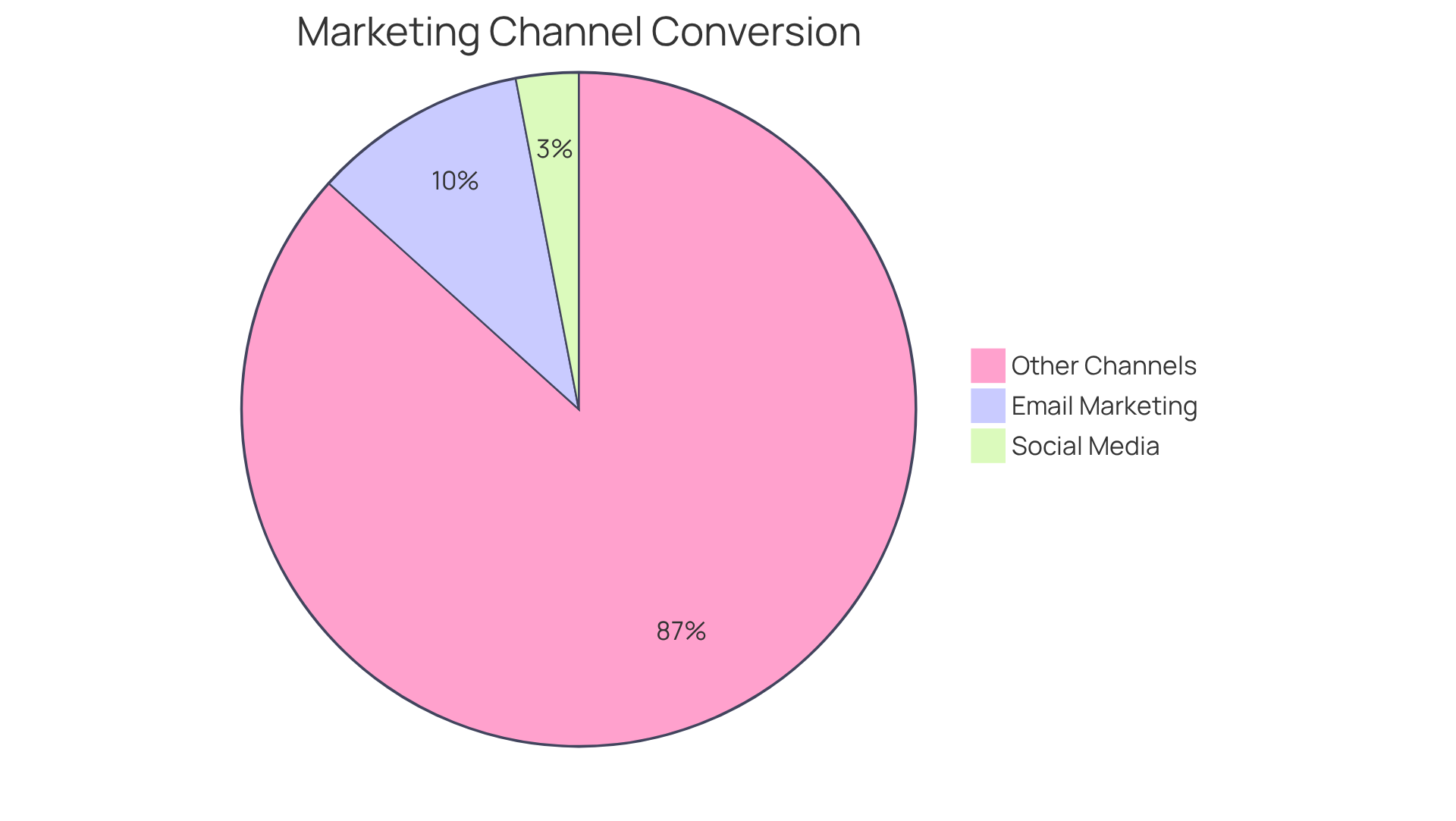
Industry Insights: Lead Conversion Rate Benchmarks You Should Know
In 2025, lead transformation metrics reveal significant disparities among sectors. The conversion rate average for the professional services sector is approximately 4.6%, while e-commerce conversion rates typically range from 2% to 4%. Understanding these benchmarks is essential for DTC companies, as it enables them to assess their performance and conversion rate average against industry standards and identify areas for enhancement.
Parah Group, a specialist in Conversion Rate Optimization (CRO), emphasizes sustainable growth and profitability through tailored strategies that have proven successful for various DTC companies. For instance, a $30M clothing label partnered with Parah Group to revamp their homepage, refine product pricing, and implement post-purchase upsells, resulting in a remarkable 35% increase in transaction levels and a 10% rise in revenue per visitor.
Moreover, segmenting performance metrics by different visitor categories—such as first-time, repeat, and registered customers—provides deeper insights into effectiveness. Regularly evaluating these metrics, alongside employing A/B testing methodologies, empowers companies to make informed tactical adjustments that enhance results and overall performance.
It is also crucial to acknowledge the challenges faced by online merchants, including high traffic and shipping costs, which can impact sales outcomes. By addressing these obstacles and leveraging insights from benchmarks and successful case studies, DTC companies can effectively refine their sales strategies.
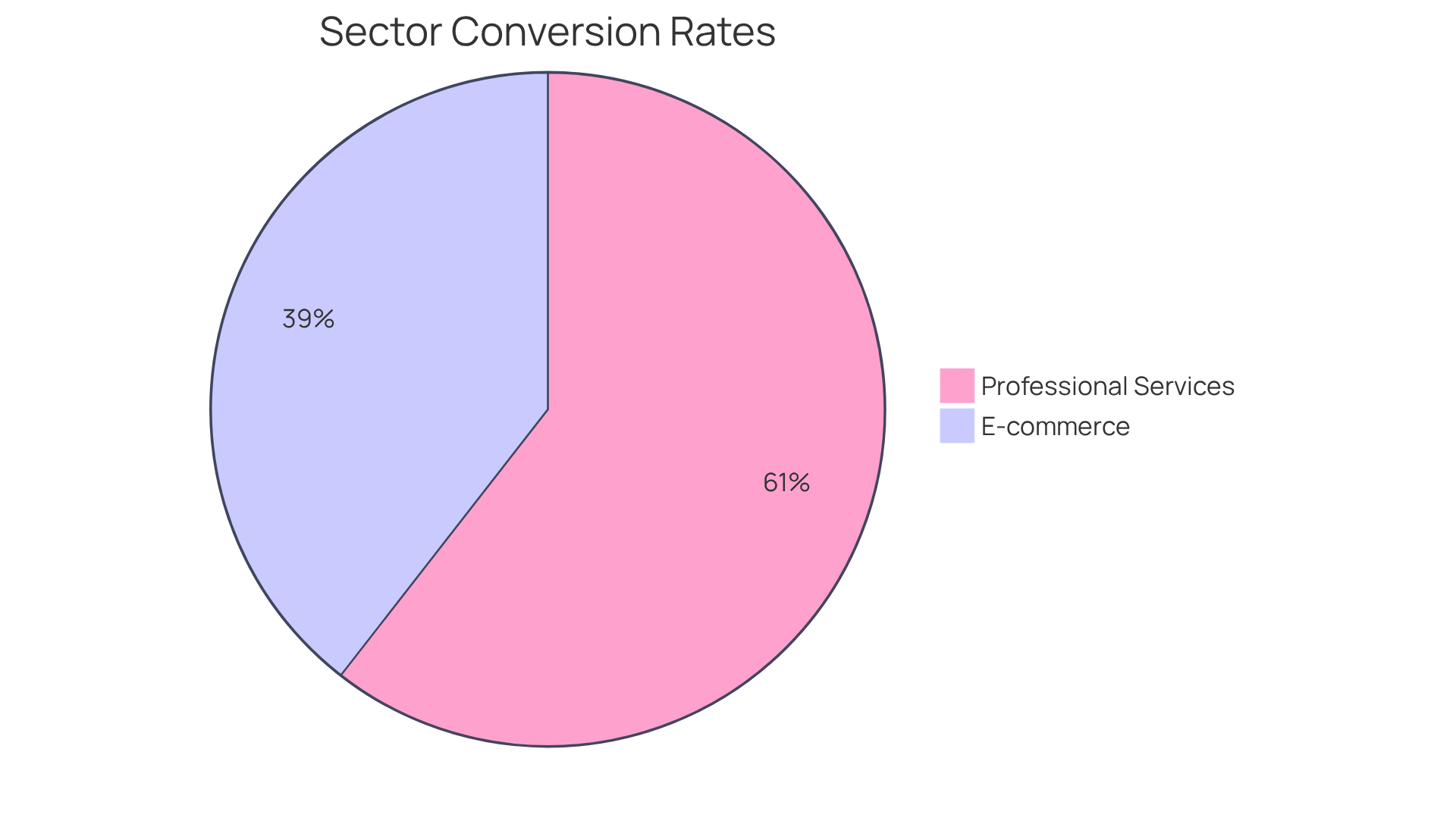
Harnessing Consumer Psychology: Enhancing Conversion Rates through Strategic Insights
Utilizing consumer psychology is essential for enhancing sales performance, with urgency and scarcity serving as two of the most powerful psychological triggers. Tactics such as 'limited time offer' or 'only a few items left in stock' can create a compelling sense of urgency, leading to quicker purchasing decisions. For instance, a $30M clothing label that revamped its homepage to emphasize social proof and testimonials experienced a remarkable 35% rise in sales. Similarly, a skincare DTC brand that included a 'Top Rated' badge on its products saw an impressive 17% increase in sales. Furthermore, incorporating social proof through customer testimonials and reviews not only builds trust but also encourages potential buyers to act. Studies indicate that prominently showcasing customer feedback can improve sales outcomes by 12-30%.
Psychologists emphasize that urgency triggers the brain's reward system, making consumers more likely to act swiftly to avoid missing out. As noted by experts, the phrase 'limited-time offer' transcends mere marketing gimmickry; it serves as a powerful cognitive lever that significantly influences buying behavior. Moreover, data indicates that countdown timers on product pages can enhance sales effectiveness by 14-20%, illustrating the profound impact of urgency and scarcity on buying choices. In a case study concerning a cannabis DTC label, offering complimentary gifts for a specific cart size and tailored landing pages resulted in a staggering 90% rise in average order value (AOV) and a 55% increase in sales effectiveness.
However, it is imperative for companies to apply these tactics ethically, ensuring they do not manipulate consumer emotions but rather motivate informed decisions. By strategically integrating these psychological insights into their marketing strategies, DTC brands can effectively enhance their conversion rate average and drive sales. Brands should also consider testing various urgency tactics to identify the most effective approach for their audience.
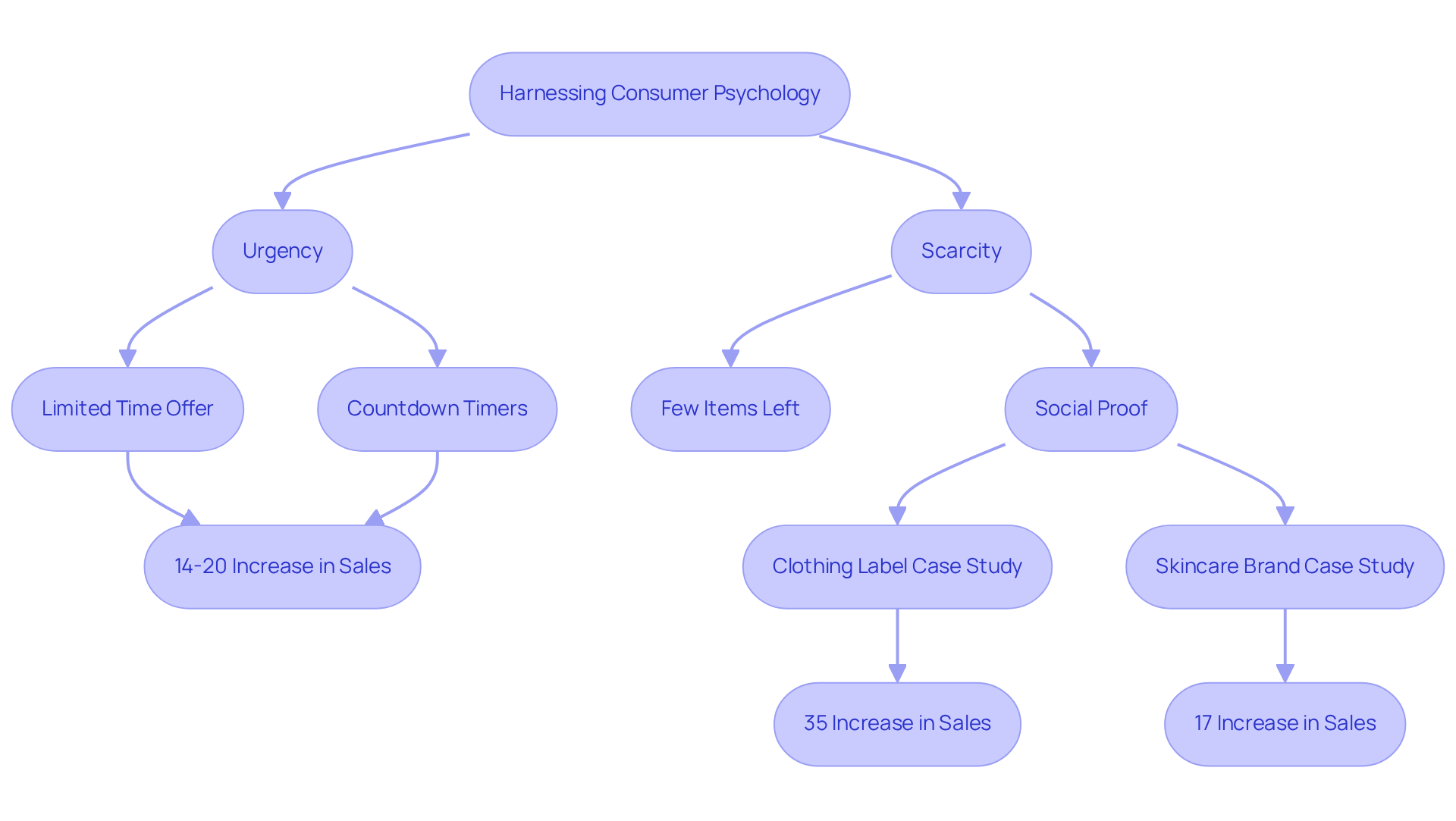
Conclusion
Understanding and optimizing conversion rates is crucial for direct-to-consumer (DTC) brands aiming for sustainable growth. Data-driven strategies and methodologies significantly enhance conversion rates, ultimately leading to increased profitability. By focusing on user experience, personalized marketing, and effective analytics, brands can unlock their full potential in a competitive marketplace.
This article delves into conversion rate averages, revealing that DTC brands can achieve success rates exceeding industry norms through targeted efforts. Key strategies such as:
- A/B testing
- Optimizing landing pages
- Leveraging social proof
yield substantial improvements. Furthermore, understanding industry benchmarks and employing consumer psychology refine marketing approaches, ensuring DTC brands stay ahead of the curve.
As the landscape evolves, it is imperative for DTC brands to remain agile and responsive to market demands. Continuously monitoring performance metrics and implementing best practices for conversion rate optimization not only enhances lead conversion rates but also fosters long-term customer relationships. Embracing these strategies is essential for thriving in an increasingly competitive environment.
Frequently Asked Questions
What is the approach used by Parah Group for Conversion Rate Optimization (CRO)?
Parah Group adopts a systematic approach to CRO that leverages data-driven techniques and consumer psychology to enhance conversion rates for direct-to-consumer (DTC) labels. This includes methodologies like user session recordings and competitor analysis, along with continuous A/B testing.
How effective is the systematic approach of Parah Group in improving conversion rates?
The systematic approach has shown remarkable results, exemplified by a 36% increase in ROI on advertisements for clients. Businesses that utilize CRO tools typically experience an average return on investment reflecting a conversion rate average of 223%.
What is the average conversion rate across different industries as of 2025?
The average conversion rate across various sectors stands at approximately 2.9%. However, DTC companies, particularly in the fashion and beauty industries, often achieve higher rates, typically ranging from 3% to 5%.
Which industries have the highest conversion rates for DTC companies?
The clothing sector has an average conversion rate of around 4.07%, while food and drink companies can reach impressive figures of up to 6.17%.
What constitutes a good conversion rate for DTC companies?
For DTC companies, a conversion rate average that exceeds 3% is often regarded as strong. In e-commerce, an acceptable range typically lies between 2% and 5%.
How can DTC companies improve their conversion rates?
Companies that effectively implement personalized marketing and enhance user experience often see significant improvements. Continuous monitoring and enhancement of strategy effectiveness are crucial, as many companies report a 10% to 35% increase in conversion rates after successful optimization techniques.
What role does consumer feedback play in CRO according to Parah Group?
CRO is fundamentally rooted in analytics and user feedback, fostering a culture that promotes informed, data-driven decision-making, as articulated by Sneh Choudhary.
FAQs











